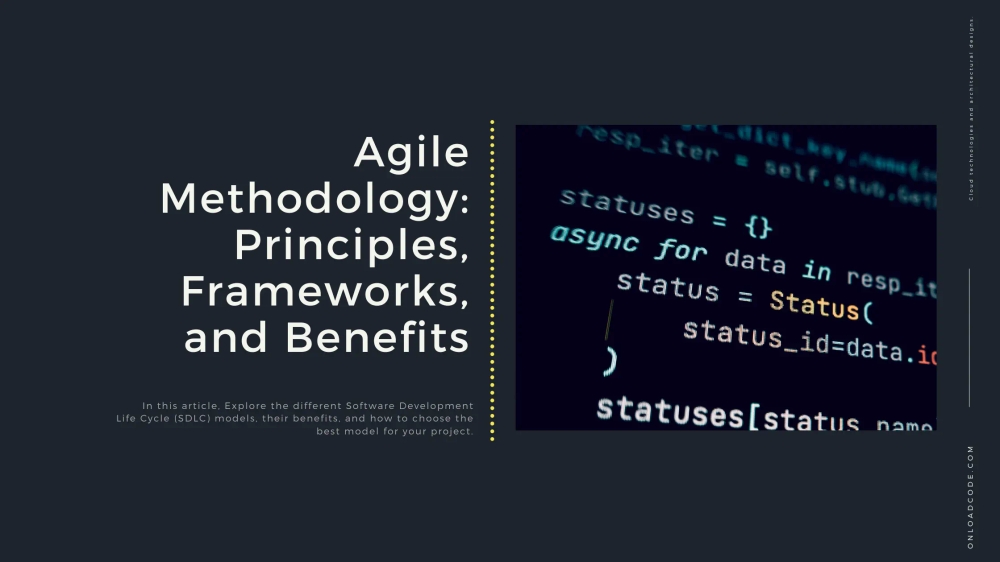Published
- 3 min read
Agile Methodology: Principles, Frameworks, and Benefits

Agile Methodology: Principles, Frameworks, and Benefits
Agile methodology is a modern software development approach that emphasizes flexibility, iterative progress, and customer collaboration. Unlike traditional models like Waterfall, Agile allows teams to adapt quickly to changes and deliver value continuously.
Core Principles of Agile
Agile is based on the Agile Manifesto, which outlines four key values:
- Individuals and interactions over processes and tools
- Working software over comprehensive documentation
- Customer collaboration over contract negotiation
- Responding to change over following a plan
The 12 Agile Principles
The Agile Manifesto also defines 12 guiding principles, including:
- Early and continuous delivery of valuable software.
- Welcoming changing requirements, even late in development.
- Delivering working software frequently (weeks rather than months).
- Collaboration between business stakeholders and developers.
- Building projects around motivated individuals and providing necessary support.
- Prioritizing face-to-face communication.
- Measuring progress through working software.
- Maintaining a sustainable development pace.
- Emphasizing technical excellence and good design.
- Keeping things simple to maximize efficiency.
- Encouraging self-organizing teams.
- Regular reflection and adaptation for improvement.
Popular Agile Frameworks
Several frameworks exist under Agile methodology, each offering different approaches to project management and software development:
1. Scrum
- Iterative development with fixed-length sprints (typically 2-4 weeks).
- Roles: Product Owner, Scrum Master, and Development Team.
- Daily stand-up meetings for progress updates.
- Sprint reviews and retrospectives for continuous improvement.
2. Kanban
- Visual workflow management using a Kanban board.
- Focuses on limiting work-in-progress (WIP) to optimize flow.
- Continuous delivery rather than fixed sprints.
3. Lean Development
- Derived from Lean Manufacturing principles.
- Focuses on reducing waste, optimizing resources, and delivering faster.
4. Extreme Programming (XP)
- Emphasizes engineering practices like test-driven development (TDD), pair programming, and continuous integration.
- Short development cycles for rapid delivery.
5. Scaled Agile Framework (SAFe)
- Extends Agile for large enterprises with multiple teams.
- Provides structured coordination for large-scale Agile projects.
Benefits of Agile
Adopting Agile offers several advantages over traditional software development methodologies:
✅ Faster Time to Market
- Agile teams deliver software in small increments, allowing faster releases.
✅ Improved Collaboration
- Frequent interactions between developers, stakeholders, and customers ensure alignment.
✅ Flexibility and Adaptability
- Agile embraces change, making it ideal for dynamic and evolving projects.
✅ Higher Quality Software
- Continuous testing, code reviews, and feedback loops improve software quality.
✅ Increased Customer Satisfaction
- Regular customer involvement ensures the final product meets expectations.
✅ Better Risk Management
- Frequent iterations reduce project risks by identifying and addressing issues early.
Agile vs. Waterfall: A Comparison
| Feature | Agile | Waterfall |
|---|---|---|
| Approach | Iterative & Incremental | Sequential |
| Flexibility | High (Adapts to changes) | Low (Fixed plan) |
| Delivery | Continuous (small releases) | Single final release |
| Customer Involvement | High (Frequent feedback) | Low (Limited involvement) |
| Risk Management | Proactive (Issues resolved early) | Reactive (Issues detected later) |
| Best For | Complex, evolving projects | Simple, well-defined projects |
When to Use Agile
Agile is best suited for:
- Projects with uncertain or evolving requirements.
- Customer-driven products that require continuous feedback.
- Teams looking for rapid and frequent releases.
- Organizations embracing collaborative and adaptive work cultures.
Conclusion
Agile methodology has transformed software development by prioritizing adaptability, collaboration, and efficiency. With frameworks like Scrum, Kanban, and XP, Agile empowers teams to deliver high-quality products faster while responding to changing business needs.
Quiz Questions
- What are the four key values of the Agile Manifesto?
- How does Scrum differ from Kanban?
- What Agile framework is best suited for large-scale enterprises?
- Why is Agile preferred over the Waterfall model for evolving projects?
- What is the main advantage of using Agile methodologies?
This guide provides an in-depth look at Agile methodologies. Let me know if you’d like any modifications! 🚀
